(Editor's Note: This article was originally published on November 24, 2007.)
Precautionary steps should be taken to protect and preserve your garden art so that it remains beautiful for many years. A wide variety of materials is used to create garden art, including concrete or cement, wood, resin, ceramics, porcelain, glass, terracotta and plastic. Metals include copper, silver, gold, brass, stainless steel and wrought iron, just to name a few. We’ll just cover protecting these basic materials here. Moisture is your treasure’s biggest enemy; harsh weather come next.
Weather extremes, from both heat and cold, occur from one end of our country to the other. Some of the materials in garden art will deteriorate if left outside in these harsh conditions. It’s up to us to protect our treasures from these elements. There are many products on the market today to help you preserve your beautiful garden art collections for the next generation. Check your local hardware stores to see what’s available in your area. Look for one of the “little old men” and ask what to use. They are wise beyond their years and will offer wonderful advice to help you find just the right products. If your local stores don’t have these products, check for sources on the Internet.
Garden art made from Concrete/Cement, including statuaries, birdbaths and fountains can crack and chip in freezing temperatures if water is left in them to freeze. Protect these items by draining any water, cleaning the object and storing it in a protected location. If you cannot move your birdbath or fountain, invert the bowls so that water doesn’t collect and freeze. The pressure from the water solidifying against the concrete or cement causes cracks and weakens the concrete. Pumps for your fountains should be removed whenever possible and be stored inside. Another option would be to purchase a bird bath heater to provide our feathered friends a nice warm bath. Look for those at your local wild bird store.
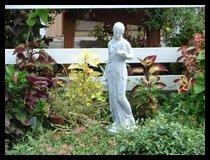
Some repairs can be made with cement/concrete repair products, like PC Crete, which can be found in hardware stores. I’ve had really good luck using this product in the past. The neck of the statue in this photo was broken when I purchased it. It was repaired using PC Crete.
Garden art made from Wood, including bamboo, can discolor, rot and or split if allowed to get wet. Wooden objects, such as planters and statues, should be coated with a sealer designed specifically to protect wood. Treat these objects annually to keep them looking beautiful. These objects should be placed so they are not in direct contact with moisture. Wooden planters should be used with plastic inserts. The one shown has plastic inside of it with a painted terra cotta pot to hold plant and dirt. When possible, these wooden objects should be thoroughly cleaned and brought indoors during winter months. This is another good reason to use a planter insert.
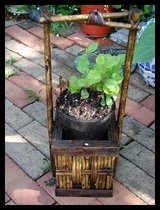
This copper and cedar fountain has been treated with both a sealer for the wood and with Everbrite for the copper and brass. It is now 2 years old and, after staying outside through our mild winters, it still looks just as good today.

Garden art made from Resin can crack and decorative paint can fade and chip if left in the sun or exposed to extreme cold weather. Resin planters and statues should be cleaned periodically and be placed in protected areas for the winter. Repairs to Resin can be made with “superglue” type products.


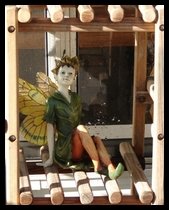
Garden art made from Ceramic can break, deteriorate and/or dissolve when exposed to extreme heat or cold. These objects should be brought in during winter months to prevent cracking from overexposure to cold.
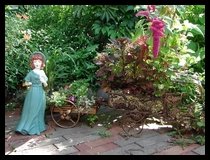

Garden art made from Porcelain can be broken and decorative paint can chip off when exposed to extreme heat or cold. These objects should be brought in during winter months to prevent cracking from overexposure to cold.
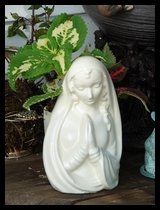
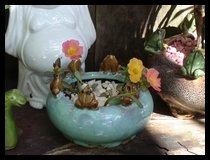
Garden art made from Terra Cotta Pottery can crack when exposed to extreme heat or cold. It’s most likely to grow mold on it if it stays damp. These objects should be moved to a protected area during winter months to prevent cracking from overexposure to cold. This mosaic planter is made from both terra cotta and glass. The lizard is made from resin.
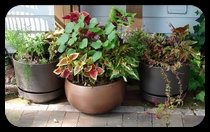
Garden art made from Plastics come in many thicknesses. The heavier plastics will probably do just fine in extreme weather. Thinner plastic objects should be brought in during winter months to prevent cracking from overexposure to cold. When plastic pots start to look bad, sometimes a face lift is all they need. The textured paint, especially the metallic colors, found in most hardware stores has become my best friend. The pot in the center is a terra cotta pot that I’ve painted with Hammered Copper Paint. The 2 flanking 15 year old plastic pots were also painted with Hammered Bronze Paint. All 3 pots were hideous before their makeovers. Now they are some of my favorite planters. We’ll talk more about garden art makeovers in another article.

Garden art made from Glass comes either solid or hollow. Both solid and hand blown glass objects should be placed in well protected areas of your garden. Both of these type of glass objects should be brought in during winter months to prevent cracking from overexposure to cold.
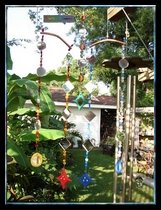
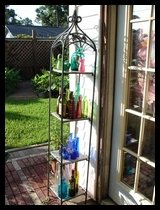
Garden art made from Copper, Silver, Gold and Brass should do very well in your garden. Expect some changes in coloration of copper. This is completely natural and desired by many people. This natural discoloration is called verdi gris. There are products available that can be purchased to protect your metal objects and sculptures from tarnish and oxidation. One such product is called Everbrite and can be found on the internet here. I’ve used this on the copper sculptures we make to keep the colors bright and beautiful.
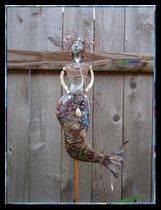
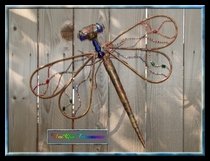

Garden art made from Stainless Steel is resistant to staining, rusting and pitting. Stainless steel has a higher resistance but still needs protecting from harsh elements.
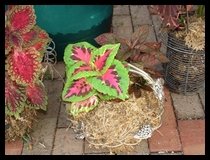
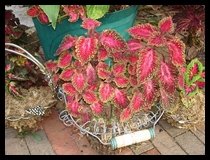
Garden art made from Wrought Iron should be cleaned and inspected for rust. Wrought Iron can be protected and renewed with paint products such as those made by Rustoleum. Look for these products in your local hardware store.
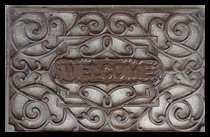
We have quite a few forums right here on Dave's Garden that discuss various types of Garden Art. Each forum has friendly and knowledgeable experts. Many of our members create their own art and are always willing and eager to advise. Look for links to some of the great discussion forums at Dave’s Garden at the bottom of this article.
Before the weather changes, it’s a good idea to thoroughly clean your garden art and either cover it up or move it to a location that offers protection from the harsh elements. It’s well worth the time, effort and money spent to preserve and protect the life of your treasures.
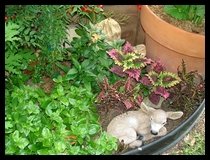
If you have questions about your specific garden art, the members here at Dave’s Garden have got the answers. Dave's Garden has many forums that include Garden Art. Click on any of these links to take you to the forums.
Garden Art Discussion Forum
Interesting and humorous reading about a Gnome Meltdown.
Garden Design Discussion Forum
Artisans Forum
Crafts and Decorating Discussion Forum
(subscriber only forum)
Mosaics and Stained Glass Discussion Forum
Woodworking Discussion Forum
Hypertufa and Concrete Discussion Forum
(subscriber only forum)
Trash to Treasure Discussion Forum
Other Forums that might interest you
Needle Arts Discussion Forum
Scrapbooking and Paper Crafts Discussion Forum
Sewing and Quilting Discussion Forum
Soap and Candle-making Discussion Forum
Computer Crafts Discussion Forum


























